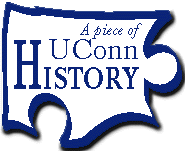|
This is an archived article.
For the latest news, go to the
Advance Homepage For more archives, go to the Advance Archive/Search Page. | ||
|
"Hang down your head, Tom Dooley." That line is from the refrain of one of the most popular songs of the folk music era of the 1950s and early 1960s. What does it have to do with UConn.
The song was a hit for the folk group Kingston Trio, and Kingston House, one of the dormitories in the Towers Complex, is named for the group. Or, rather, for a group of UConn students who called themselves the Kingston Club, after their music idols. According to the unpublished history of the University written by Evan Hill, emeritus professor of journalism, the Kingston Club was a group of "about a dozen sophomore men at the Hartford campus in 1961." When they transferred to Storrs, "they requested permission to live together and named their house the Kingston House - despite university administrators' desire to name all houses after famous Connecticut persons." Hill adds that everyone in the newly-named Kingston House was placed on social probation for one semester because, during the first week the house was open, "a forbidden champagne party (was) discovered by officials when they saw dozens of champagne bottles in the house's trash barrels the following morning." Most of the other dormitories in Towers, all of which opened in 1961, are named for Connecticut notables. Allen House is named for Willard H. Allen (1894-1957), a 1916 graduate of Connecticut Agricultural College. He was an honor student and a member of the track and football teams, as well as the first student to major in animal husbandry. A one-time president of the Alumni Association, he also was the recipient of a Distinguished Alumni Award. Colt House is named after Samuel Colt (1814-1862), the Hartford-born inventor who manufactured the first practical revolving firearm. Fenwick House is named for Lady Alice Boteler Fenwick, wife of Col. George Fenwick, governor of the Saybrook settlement at the mouth of the Connecticut River from 1639 to 1644. Lady Fenwick was the first noblewoman to settle in Connecticut. Saybrook was planned as a baronial center for aristocratic sympathizers of Oliver Cromwell. Hamilton House is named for Dr. Alice Hamilton (1869 to 1970), a Haddam physician who is considered the founder of the profession of occupational medicine. Her work recognized the occupational hazards of certain jobs, such as black lung disease among coal miners, and helped set safety standards for industry. Keller House is named for Helen Keller (1880-1968), whose story as a blind and deaf child is well known through William Inge's play The Miracle Worker. An internationally known and admired writer and lecturer, Keller was a resident of Westport, Conn., at the time of her death in 1968. When the dormitory was named for her in 1961, it was a break in the tradition of naming buildings posthumously. Morgan House is named for the Hartford-born multi-millionaire, financier J. Pierpont Morgan. Morgan in 1907 averted a widespread U.S. financial collapse after a Wall Street panic, by mobilizing the banking strength of New York City. Vinton House is named for Annie Vinton (1871-1961), a long-time resident of Mansfield with an abiding interest in education. Vinton was Mansfield's state representative in the General Assembly from 1923 to 1927 and served on the appropriations committee. The Annie E. Vinton elementary school in Mansfield on Route 32 also was named for her. Wade House is named after Susanna Wade, one of the original property owners in Mansfield. Wade inherited land in Mansfield from her husband before the division of Windham and Mansfield in 1702. In 1709 and 1710 she acquired four other pieces of property in Mansfield, according to town records, at a time when land ownership by women was rare. Little more is known about Wade, however. Although most of the names of the Towers dormitories recall local dignitaries, there is another musical connection - one that brings to mind the Fourth of July fireworks of a Sousa march. Sousa House is named for John Philip Sousa (1854-1932), a composer and bandmaster who led the U.S. Marine Band for 12 years, then formed his own marching band in 1892 and conducted it for 40 years. Sousa invented the sousaphone and composed such memorable marches as "Stars and Stripes Forever" and "The Washington Post March." Home to many marching band members when it was named, in the 1960s the dormitory was one of a few serving weekend meals. Mark J. Roy Source: unpublished manuscript, Evan Hill, 1981. This document and many others about the history of the University are held in the archives at the Thomas J. Dodd Research Center. |

